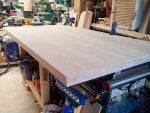The "Director of Home Economics" wants me to make her a table out of Macrocarpa. Top will be 2.5m long and consist of several (6 or 7) boards 200mm wide. but she does not want breadboard ends. Legs will project up thru the top and finish level with the top of the table. The table will finish with a sandblasted/distressed look
My question is how thick should I make the boards given that I need to be able to move it without calling in a team of men to help but at the same time I want to minimise (prevent) any sag over that length. Would 30mm (approx 1.25") be sufficient or could I get away with 25mm (1")
Hmm this might also be a good project to start to learn Sketchup with:surprise: ....unless I can find some suitable plans as a basis.
Alan
My question is how thick should I make the boards given that I need to be able to move it without calling in a team of men to help but at the same time I want to minimise (prevent) any sag over that length. Would 30mm (approx 1.25") be sufficient or could I get away with 25mm (1")
Hmm this might also be a good project to start to learn Sketchup with:surprise: ....unless I can find some suitable plans as a basis.
Alan








